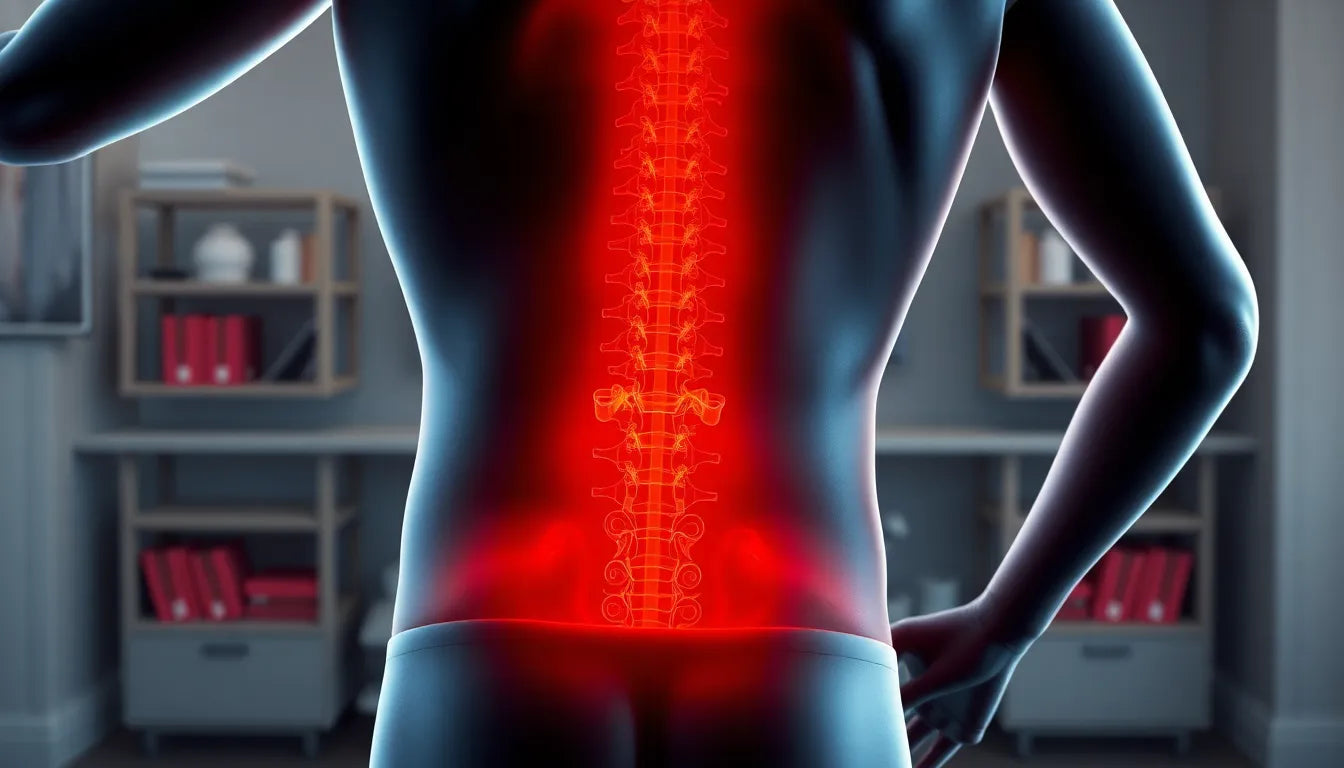Understanding the intricate relationship between herniated discs and muscle spasms is crucial for anyone seeking relief from these often debilitating symptoms. A herniated disc occurs when the soft inner gel of a spinal disc pushes through a crack in the tougher exterior casing. This can irritate nearby nerves and lead to a variety of symptoms, including muscle spasms. These involuntary muscle contractions are not only painful but can also significantly disrupt daily activities.
Muscle spasms resulting from a herniated disc are a common issue that many individuals face. The spasms can manifest as sudden, sharp pains or as a persistent, dull ache. They often occur because the body is trying to protect itself from further injury by immobilizing the affected area. This protective mechanism, while well-intentioned, can lead to stiffness and reduced mobility, making everyday tasks challenging.
the impact on daily life
The impact of muscle spasms on one's daily life cannot be overstated. These spasms can severely limit mobility, making it difficult to perform even the simplest of tasks, such as bending over to pick something up or turning your head to look in a different direction. For individuals who rely on physical activity for their livelihood or personal satisfaction, this can be particularly distressing.
Moreover, the constant discomfort and pain can lead to decreased productivity, both at work and at home. This can result in a sense of frustration and helplessness, further exacerbating the situation. The quality of life can be significantly diminished as individuals struggle to find comfortable sleeping positions, leading to poor sleep quality and fatigue. It's not just about managing the pain; it's about regaining control over one's life and ensuring long-term health and well-being.
Addressing these muscle spasms is not just about finding immediate relief, though that is certainly important. It's also about implementing strategies that provide long-term solutions and prevent recurrence. By understanding the root causes and the impact of these spasms, individuals can take proactive steps to manage their condition and improve their overall quality of life.
common and effective interventions for muscle spasms
When dealing with muscle spasms caused by a herniated disc, several interventions can provide relief and improve quality of life. One of the most accessible methods is heat therapy. Applying a heating pad or taking a warm bath can significantly increase blood flow to the affected area, helping to relax tight muscles and reduce discomfort. For optimal results, apply heat for 15-20 minutes at a time, ensuring the temperature is comfortable to prevent burns. This simple yet effective approach can be easily integrated into daily routines, offering both immediate relief and long-term benefits.
Massage therapy is another powerful tool in managing muscle spasms. Whether through professional sessions or self-massage techniques, this therapy helps alleviate tension and promote circulation. For those opting for self-massage, using a foam roller or a tennis ball to gently work out knots in the muscles can be particularly beneficial. Start with light pressure and gradually increase it as your muscles begin to relax. This hands-on approach not only reduces spasms but also enhances overall muscle health.
the role of stretching and physical therapy
Incorporating stretching and physical therapy into your routine can significantly improve flexibility and strength, addressing the root causes of muscle spasms. Techniques such as the McKenzie method are specifically designed to centralize pain and improve spinal alignment. These exercises focus on extending the spine, which can help alleviate pressure on the nerves affected by a herniated disc. It's crucial to work with a physical therapist to develop a personalized exercise plan that caters to your specific needs, ensuring safe and effective practice.
medication and lifestyle adjustments for relief
For many, medication plays a key role in managing muscle spasms. Over-the-counter options like NSAIDs (non-steroidal anti-inflammatory drugs) and analgesics can provide short-term relief by reducing inflammation and pain. In some cases, muscle relaxants may be prescribed for more severe spasms. However, it's essential to consult with a healthcare professional before starting any medication to ensure it's appropriate for your condition.
Beyond medication, making lifestyle changes can also help prevent the recurrence of muscle spasms. Ergonomic adjustments, such as using a supportive chair or adjusting your workstation, can reduce strain on the back. Managing stress through mindfulness practices or regular exercise can further alleviate tension. Additionally, maintaining a healthy weight through balanced nutrition and low-impact aerobic activities supports overall spinal health, reducing the likelihood of future spasms.
integrating holistic approaches for lasting relief
Taking a holistic approach by combining these interventions can lead to more comprehensive and lasting relief from muscle spasms. By addressing both the immediate symptoms and underlying causes, individuals can regain control over their lives and improve their overall well-being. It's about creating a balanced routine that incorporates therapeutic practices, medication when necessary, and lifestyle adjustments. This integrated approach not only provides relief but also empowers individuals to take proactive steps towards a healthier, more active life.
exploring additional therapies and techniques
Beyond the commonly discussed interventions, there are additional therapies and techniques that can provide significant relief from muscle spasms caused by herniated discs. TENS (Transcutaneous Electrical Nerve Stimulation) and traction therapy are two such methods. TENS therapy involves using a device to send low-voltage electrical currents through the skin to stimulate the nerves in the affected area. This can help reduce pain and improve muscle function by interrupting pain signals and encouraging the release of endorphins. Traction therapy, on the other hand, involves gentle spinal stretching, which can help relieve pressure on the discs and nerves, promoting healing and reducing spasms.
Another critical aspect of managing muscle spasms is paying attention to sleep positions. Adjusting how you sleep can significantly reduce pressure on the herniated disc and alleviate symptoms. For instance, sleeping on your back with a pillow under your knees or on your side with a pillow between your legs can maintain proper spinal alignment and reduce discomfort. Additionally, techniques such as myofascial release, which involves applying gentle pressure to the myofascial connective tissue, can help relieve muscle tension and improve mobility.
centralization techniques for pain management
The McKenzie method is a well-established therapy for managing pain associated with herniated discs. This technique focuses on centralizing nerve pain to the lumbar area, making it easier to manage and treat. By performing specific exercises that extend the spine, individuals can help shift the pain from the extremities back to the lower back, reducing the overall intensity and frequency of spasms. This approach not only aids in immediate pain relief but also contributes to long-term spinal health by promoting proper alignment and strengthening supporting muscles.
frequently asked questions
What are the first steps to take when experiencing a muscle spasm from a herniated disc?
When a muscle spasm occurs, it's crucial to act quickly to alleviate discomfort. Start by applying heat to the affected area using a heating pad or warm bath to relax the muscles. Gentle stretching exercises can also help ease tension and improve mobility. If pain persists, consider consulting a healthcare professional for further guidance.
How long does it typically take to see improvement with these interventions?
The timeline for improvement varies depending on the severity of the condition and the interventions used. Generally, individuals may start noticing relief within a few days to a week with consistent application of heat therapy and stretching. More comprehensive approaches, including physical therapy and lifestyle adjustments, may take several weeks to show significant results.
Are there any activities or movements that should be avoided to prevent worsening the condition?
To prevent exacerbating the condition, avoid activities that involve heavy lifting, twisting motions, or prolonged sitting or standing without breaks. Instead, opt for low-impact exercises such as walking or swimming, which can help maintain fitness without putting additional strain on the back.
How can ergonomic products help in managing muscle spasms?
Ergonomic products, such as supportive chairs, lumbar cushions, and adjustable desks, can play a vital role in managing muscle spasms by promoting proper posture and reducing strain on the spine. These aids help maintain spinal alignment and distribute weight evenly, minimizing the risk of further injury and discomfort.
Sources
- Barricaid Blog. "How to Stop Muscle Spasms from Herniated Disc."
- MoreGoodDays. "Herniated Disc Recovery: Long-term Solutions and Lifestyle Changes."
- Sciatica.com. "Treatments for Herniated Disc: Physical Therapy and More."
- Spine-Health. "Muscle Spasms and Herniated Discs: Managing Pain and Improving Function."


















